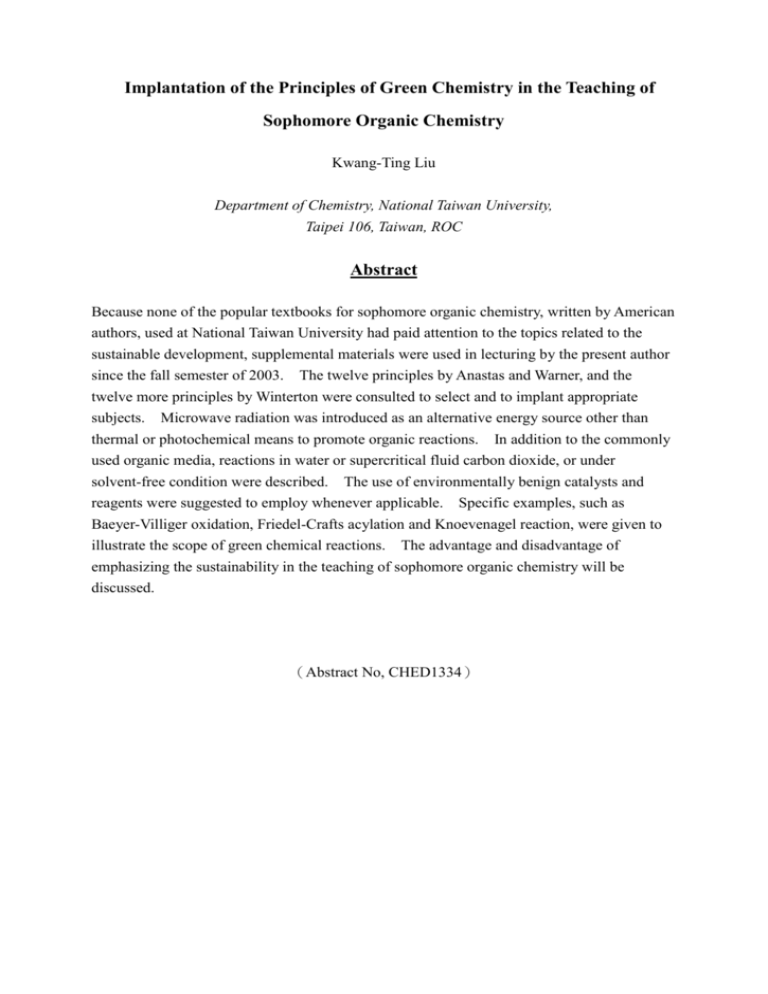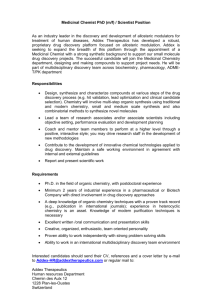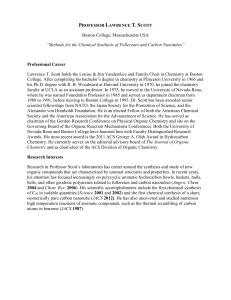
Implantation of the Principles of Green Chemistry in the Teaching of
Sophomore Organic Chemistry
Kwang-Ting Liu
Department of Chemistry, National Taiwan University,
Taipei 106, Taiwan, ROC
Abstract
Because none of the popular textbooks for sophomore organic chemistry, written by American
authors, used at National Taiwan University had paid attention to the topics related to the
sustainable development, supplemental materials were used in lecturing by the present author
since the fall semester of 2003. The twelve principles by Anastas and Warner, and the
twelve more principles by Winterton were consulted to select and to implant appropriate
subjects. Microwave radiation was introduced as an alternative energy source other than
thermal or photochemical means to promote organic reactions. In addition to the commonly
used organic media, reactions in water or supercritical fluid carbon dioxide, or under
solvent-free condition were described. The use of environmentally benign catalysts and
reagents were suggested to employ whenever applicable. Specific examples, such as
Baeyer-Villiger oxidation, Friedel-Crafts acylation and Knoevenagel reaction, were given to
illustrate the scope of green chemical reactions. The advantage and disadvantage of
emphasizing the sustainability in the teaching of sophomore organic chemistry will be
discussed.
(Abstract No, CHED1334)
Introduction
The modern American educational system was adopted by the Chinese administration
with some modification since 1922. When Japan surrendered to the Allies in 1945 and
China resumed the sovereignty of Taiwan, the Japanese educational system in there was also
replaced by the Chinese one. It has been lasted ever since.
At National Taiwan University the introductory course of organic
chemistry is giv1en in sophomore year, except some agriculture and
life-science students. There are three kinds of courses and each one has
several sections taught by different professors. In general, an American
textbook is chosen for individual section according to the preference of
professors. (Many universities in Taiwan have their teaching of organic chemistry in a
similar way, but different textbooks may be used.)
I taught “Organic Chemistry B” for students major in agricultural
chemistry since September 2003. It is a two-semester course consists of
three hours of lecturing and one hour of recitation. To choose a textbook
for my class I had browsed the latest edition of several popular ones, such
as:
1. Brown, W. H.; Foote, C. S. Organic Chemistry, 3rd edition, Brooks/Cole, 2002
2. Loudon, G. M. Organic Chemistry, 4th edition, Oxford University Press, 2002
3. Vollhardt, R. P. C.; Schore, N. E. Organic Chemistry, 4th edition, Freeman, 2003
4. Wade, L. G. Jr. Organic Chemistry, 5th edition, Prentice Hall, 2003
However, except greenhouse
gases and ozone depletion, in those books little attention was paid to the
topics related to the sustainable development, let alone green chemistry. In
the one by Vollhardt and Schore became my choice.
one book (Brown and Foote) different industrial syntheses of ibuprofen were discussed, but
Therefore, supplemental materials
about green chemistry were used in lecturing.
A year later, new edition of other popular textbooks were published,
the BHC method was not even mentioned.
including:
1. Bruice, P. Y. Organic Chemistry, 4th edition, Pearson/Prentice Hall, 2004.
2. McMurry, J. Organic Chemistry, 6th edition. Thomson/Brooks/Cole, 2004.
3. Solomom, T. W. G.; Fryhle, C, B, Organic Chemistry, 8th edition. Wiley, 2004.
To my surprise, green chemistry was not introduced except the textbook
by Solomon and Fryhle. Even so, only the discussion of green
Baeyer-Villiger oxidation and the prohibition of using benzene in chemical
synthesis are in the main text, the other three topics (alkene oxidation,
nylon synthesis and PET recycling) were given in the box of “The
Chemistry of….” Like those mentioned previously, the other two textbooks have some
description on greenhouse gases and ozone depletion, but nothing else related to green
2
chemistry.
Because green or sustainable chemistry is rapidly becoming the wave of the future, I
believe that it is very important that students are exposed to green chemistry
in many courses across their chemistry curriculum, especially the future
chemists should be taught to have sufficient knowledge in sustainability and
to think “green” in dealing with real world problems. Although quite a
few green chemistry modules (such as those developed from the University of Scranton)
are available for insertion into specific courses, from my previous
experience, students in general would not catch the significance of a new
concept unless it is given repeatedly in different topics over the semester or
the school year. Consequently, supplemental materials about green
chemistry have been incorporated in my lectures scattered through the
year.
Topics for lecturing
The following topics concerning “basic principles and practices” of green chemistry have
been given.
(A) Introduction to organic chemistry (the first lecture)
In the very beginning of the course the following fundamental concepts in green
chemistry are made:
1. Organic chemistry is the chemistry of carbon compounds. The global
carbon cycle and the disruption due to human activities (since industrial
revolution) are briefly discussed.
2. The definition of sustainable development (The development that meets the
needs of the present without compromising the ability of future generations to meet their
own needs-UN Commission Report, 1987)
3. Major challenges to sustainable development (population, energy, global change,
resource depletion, food supply and toxics in environment), and the role of chemistry
in solving problems.
4. The definition of green chemistry or sustainable chemistry. (Green
Chemistry or environmentally benign chemistry is the invention, design and application of
chemical products and processes that reduce or eliminate the use and generation of
hazardous substances- OCED Workshop on Sustainable Chemistry, 1998)
5. The key concepts of green chemistry, based on the 12 principles by Anastas and
Warner, and the 12 more principles by Winterton. (Appendix 1)
(B) Introduction to organic reactions
To introduce organic reactions the following points are given briefly:
1. Microwave and ultrasound methods as alternative means to promote
reactions (other than thermal and photochemical methods).
3
2. Supercritical fluid carbon dioxide and water as useful and “greener”
reaction media than volatile organic solvents.
3. Solvent-free reactions and their advantages.
(C) Haloalkanes
1. The effects of many “useful” haloalkanes (such as CFC, HCFC, HFC and others)
to the depletion of ozone layer and global warming.
2. Efforts to find environmentally benign aerosols, anesthesia, solvents used
in dry-cleaning, etc. as opportunities for chemists.
(D) Principles of organic synthesis (an introductory lecture)
1. In the lecture to introduce a successful organic synthesis, in addition to those
traditionally mentioned (such as brevity, high yield, readily available chemicals,
retrosynthetic analysis) environmentally benign procedure and “atom
economy” were emphasized. Examples of various reactions (substitution,
elimination, addition, etc.) were given.
2. Moreover, the students were asked to calculate “experimental atom
efficiency,” that is, experimental atom economy (for actual quantities of
reagents used, according to “Green Chemistry Module,” University of Scranton) ×
percentage yield, for the organic preparations they performed in the
organic laboratory course. (Appendix 2)
(E) Oxidations
In the beginning lecture of oxidation in organic chemistry,
1. Principles of green oxidation. oxidants commonly used in organic
chemistry are discussed in the environmental and atom efficient concern.
2. Oxidations using H2O2 catalyzed by Ti-molecular sieves (Notari, 1998).
3. Epoxidation using hydrogen peroxide and a variety of catalysts (Kamata,
2003).
4. Dihydroxylation of alkenes with hydrogen peroxide and resin-supported
sulfonic acid catalyst. (2003)
5. Cleavage of C=C using hydrogen peroxide with tungstate catalysts and
“green synthesis” of adipic acid.
6. Microwave-assisted oxidation with supported oxidizing agents.
7. Catalytic air oxidation of alcohols in aqueous media.
(F) Diels-Alder reactions
1. Comparison of traditional reaction and microwave-assisted reaction.
2. Advantages of reaction in aqueous media, higher endo selectivity, faster.
4
(G) Electrophilic Aromatic substitutions
1. Friedel-Crafts acylation using no-chlorine catalysts (e. g., HF and Ac2O in
Ibuprofen synthesis)
2. Solvent-free nitration over zeolite H+beta.
3. Microwave assisted bromination, comparison of ordinary and green
synthesis.
(H) Carbonyl compounds
1. Green oxidation for preparations.
2. Green reduction by using various methods.
3. “Green” Baeyer-Villiger oxidations.
4. “Grignard-like” reactions in aqueous media.
5. Microwave assisted condensation reactions, such as Knoevenagel reaction
and imine formation.
(I) Carboxylic acid derivatives
1. The greener anhydride (acetic trifluoroacetic anhydride) with similar
reactivity as acid chloride (including the Eastman process of synthesis).
2. Microwave-assisted esterifications.
3. DuPont method for recycling scrap PET as an example of
transesterifications.
4. Greener route to caprolactam.
5. New surfactants, polymers containing both CO2-phobic and CO2-philic
segments, used for cleaning in supercritical fluid CO2.
(J) Biomolecules
1. The transformation of fats and oils to fuels.
2. Glucose as the starting material for environmentally benign synthesis
using microbes.
3. From aspartic acid to polyaspartate, a biodegradable polymer.
It will take about 10 hours (about one-ninth of my lecture hour per year) for
lecturing the above-mentioned topics. In other words, the lecture time for
basic organic chemistry at sophomore level will be reduced significantly at
the expense for teaching supplementary materials in “green” organic
chemistry. Since both are important to students, such a dilemma has to be solved.
Moreover, supplemental reading materials must be given to the students, which
will be an extra work for the lecturer.
A new textbook containing the principles and practices of green chemistry
in the main text and problems of various chapters is needed.
5
Appendix 1. The key concepts of green chemistry
1. Do our best to make “carbon cycle” sustainable.
2. Prevent the waste rather than treat or clean up waste after it is formed.
3. Economize on atoms by choosing synthetic methods which will maximize the
incorporation of all or most of the reactant atoms into the desired product.
4. Design processes to use nontoxic starting materials and solvents, and to minimize the
potential for chemical accidents, including releases, explosions, and fires.
5. Find ways to use renewable starting materials and catalytic reagents.
6. Minimize the use of utilities (electricity, gas, water and steam).
7. Avoid the use of auxiliary substances (solvents, separation agents, etc.) whenever
possible.
8. Invent chemical products which are environmentally benign, easily degradable, or
recyclable.
Appendix 2. Experimental Atom efficiency
Percentage yield = (Actual yield/Theoretical yield) × 100%
Atom economy is a measure of how many atoms of a reaction end up in the final product and
how many end up in byproducts or waste in theory.
Atom Economy
relative molecular mass of desired products
100%
relative molecular mass of all reactants
But in practice, many reagents are in excess. So, “Experimental atom economy” is used.
Experiment al atom economy
relative molecular mass of desired products
100%
relative molecular mass of all chemicals used
And the efficiency of an experiment in terms of atom economy can be defined as:
Experimental atom efficiency = Experimental atom economy × Percentage yield
Example: Cyclohexanol and phosphoric acid give cyclohexene and water on heating.
H3PO4
C6H12O 85%
C6H10 H2O
Reactants: cyclohexanol (C6H12O, 10.0 g, 0.1 mole)
85% H3PO4 (5 mL: 7.15 g H3PO4, 0.073 mole; 1.26 g H2O, 0.070 mole)
Desired product: cyclohexene (C6H10, 8.2 g, 0.1 mole in theory)
Atom Economy = 8.2/10.0 = 82%
∴ Experimental atom economy = 8.2/18.4 = 44.6%
average yield in a student laboratory, 30%
∴ Experimental atom efficiency = 44.6% × 30% = 13.4%
6







